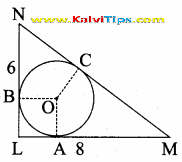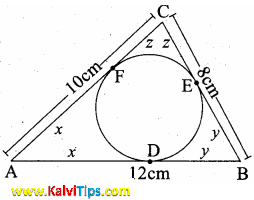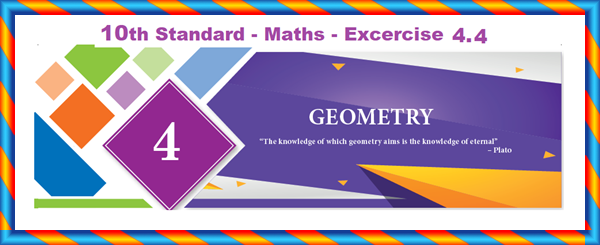Tamil Nadu Board 10th Standard Maths - Chapter 4 Unit Exercise 4.4: Book Back Answers and Solutions
This post covers the book back answers and solutions for Chapter 4 Unit Exercise 4.4 – Maths from the Tamil Nadu State Board 10th Standard textbook. These detailed answers have been carefully prepared by our expert teachers at KalviTips.com.
We have explained each answer in a simple, easy-to-understand format, highlighting important points step by step under the relevant subtopics. Students are advised to read and memorize these subtopics thoroughly. Once you understand the main concepts, you’ll be able to connect other related points with real-life examples and confidently present them in your tests and exams.
By going through this material, you’ll gain a strong understanding of Chapter 4 Unit Exercise 4.4 along with the corresponding book back questions and answers (PDF format).
Question Types Covered:
- 1 Mark Questions: Choose the correct answer, Fill in the blanks, Identify the correct statement, Match the following
- 2 Mark Questions: Answer briefly
- 3, 4, and 5 Mark Questions: Answer in detail
All answers are presented in a clear and student-friendly manner, focusing on key points to help you score full marks.
All the best, Class 10 students! Prepare well and aim for top scores. Thank you!
Chapter 4 Algebra Unit Ex 4.4
Answer Key:
Let the radius AB be r. In the right ∆ ABO,
OB2 = OA2 + AB2
252 = 242 + r2

(25 + 24) (25 – 24) = r2
r = =7
Radius of the circle = 7 cm
Answer Key:
MN2 = LN2 + LM2
= 62 + 82 = 36 + 64 = 100
MN = = 10

AN = CN (Tangent of the circle)
LN – AL= CN
LN – r = CN
8 – r = CN ……(1)
MC = MB (tangent of the circle)
MC = ML – LB
MC = 6 – r …….(2)
.png)
MC + CN = (6 – r) + (8 – r)
MN = 14 – 2r
10 = 14 – 2r
2r = 14 – 10 = 4
r = = 2 cm
radius of the circle = 2 cm

BD = BE = y (tangent of the circle)
CE = CF = z (tangent of the circle)
AB = AD + DB
x + y = 12 ……(1)
BC = BE + EC
y + z= 8 …….(2)
AC = AF + FC
x + z = 10 ……(3)
Add (1) (2) and (3)
2x + 2y + 2z = 12 + 8 + 10
x + y + z = = 15 …….(4)
By x + y = 12 in (4)
z = 3
y + z = 8 in (4)
x = 7
x + z = 10 in (4)
y = 5
AD = 7 cm; BE = 5 cm and CF = 3 cm
Answer Key:
In ∆OPQ, we know

(Sum of the angles of a ∆ is 180°)
60° + 90° + ∠OPQ = 180°
∠OPQ = 180° – 150° = 30°
∠OPQ = 30°
Answer Key:
Given ∠ABT = 65°
∠OBT = 90°(TB is the tangent of the circle)
∠ABO = 90° – 65° = 25°
∠ABO + ∠BOA + ∠OAB = 180°
25° + x + 25° = 180° (Sum of the angles of a ∆)

∴ ∠ABO = ∠BAO = 25°
x + 50 = 180°
x = 180° – 50° = 130°
∴ ∠BOA = 130°

PT2 = OT2 – OP2
= 132 – 52
= 169 – 25
= 144
PT = = 12 cm
Since lengths of tangent drawn from a point to circle are equal.
∴ AP = AE = x
AT = PT – AP
= (12 – x) cm
Since AB is the tangent to the circle E.
∴ OE ⊥ AB
∠OEA = 90°
∠AET = 90°
In ∆AET, AT2 = AE2 + ET2
In the right triangle AET,
AT2 = AE2 + ET2
(12 – x)2 = x2 + (13 – 5)2
144 – 24x + x2 = x2 + 64
24x = 80 ⇒ x =
BE = cm
AB = AE + BE
=
Lenght of AB = cm
Answer Key:
Here AP = PB = 8 cm
In ∆OPA,
OA2 = OP2 + AP2

= 36 + 64
= 100
OA = = 10 cm
Radius of the larger circle = 10 cm
Answer Key:
In ∆ OO’P
(O’O)2 = OP2 + O’P2
= 32 + 42

(OO’)2 = 25
∴ OO’ = 5cm
Since the line joining the centres of two intersecting circles is perpendicular bisector of their common chord.
OR ⊥ PQ and PR = RQ
Let OR be x, then O’R = 5 – x again Let PR = RQ = y cm
In ∆ ORP, OP2 = OR2 + PR2
9 = x2 + y2 …(1)
In ∆ O’RP, O’P2 = O’R2 + PR2
16 = (5 – x)2 + y2
16 = 25 + x2 – 10x + y2
16 = x2 + y2 + 25 – 10x
16 = 9 + 25 – 10x (from 1)
16 = 34 – 10x
10x = 34 – 16 = 18
x = = 1.8 cm
Substitute the value of x = 1.8 in (1)
9 = (1.8)2 + y2
y2 = 9 – 3.24
y2 = 5.76
y = = 2.4 cm
Hence PQ = 2 (2.4) = 4.8 cm
Length of the common chord PQ = 4.8 cm
Answer Key:
Given: ABC is a triangle. AD, BE and CF are the angle bisector of ∠A, ∠B, and ∠C.
To Prove: Bisector AD, BE and CF intersect
Proof: The angle bisectors AD and BE meet at O. Assume CF does not pass through O. By angle bisector theorem.
AD is the angle bisector of ∠A
BE is the angle bisector of ∠B

CF is the angle bisector ∠C
Multiply (1) (2) and (3)
So by Ceva’s theorem.
The bisector AD, BE and CF are concurrent.
Answer Key:
By construction D, E, F are collinear.
By Menelaus’ theorem
AD = 2 cm; AE = EB = 4 cm; BC = 6 cm; FC = FB + BC = x + 6
In ∆ABC, By Pythagoras theorem.

AC2 = 82 + 62 = 64 + 36 = 100
AC = = 10
CD = AC – AD
= 10 – 2 = 8 cm
Substituting the values in (1) we get
4x = x + 6
3x = 6 ⇒ x = = 2
The value of BF = 2 cm

Let FB be x
Using Ceva’s theorem we have
2x = 4 ⇒ x = = 2
The value of BF = 2
Given Radius = 3.4 cm

- Draw a circle with centre “O” of radius 3.4 cm.
- Take a point P on the circle Join OP.
- Draw a perpendicular line TT’ to OP which passes through P.
- TT’ is the required tangent.
Answer Key:

- With O as centre, draw a circle of radius 4.5 cm.
- Take a point L on the circle. Through L draw any chord LM.
- Take a point M distinct from L and N on the circle, so that L, M, N are in anti-clockwise direction. Join LN and NM.
- Through “L” draw tangent TT’such that ∠TLM = ∠MNL
- TT’ is the required tangent.
Answer Key:

- With O as centre, draw a circle of radius 5 cm.
- Draw a line OP =10 cm.
- Draw a perpendicular bisector of OP, which cuts OP at M.
- With M as centre and MO as radius draw a circle which cuts previous circle at A and B.
- Join AP and BP. AP and BP are the required tangents.
PA2 = OP2 – OA2
= 102 – 52 = = 8.7 cm
Lenght of the tangent is = 8.7 cm
Answer Key:
Radius = 4 cm; Distance = 11 cm

- With O as centre, draw a circle of radius 4 cm.
- Draw a line OP = 11 cm.
- Draw a perpendicular bisector of OP, which cuts OP at M.
- With M as centre and MO as radius, draw a circle which cuts previous circle A and B.
- Join AP and BP. AP and BP are the required tangents.
Verification: In the right angle triangle OAP
PA2 = OP2 – OA2
= 112 – 42 = 121 – 16 = 105
PA = = 10.2 cm
Length of the tangents = 10.2 cm
Answer Key:

- With O as centre, draw a circle of radius 3 cm.
- Draw a line OP = 5 cm.
- Draw a perpendicular bisector of OP, which cuts OP at M.
- With M as centre and MO as radius draw a circle which cuts previous circles at A and B.
- Join AP and BP, AP and BP are the required tangents.
Verification: In the right angle triangle OAP
PA2 = OP2 – OA2
= 52 – 32
= 25 – 9
= 16 PA
= = 4 cm
Length of the tangent = 4 cm
Answer Key:
Radius = 3.6; Distance = 7.2 cm.

- With O as centre, draw a circle of radius 3.6 cm.
- Draw a line OP = 7.2 cm.
- Draw a perpendicular bisector of OP which cuts OP at M.
- With M as centre and MO as radius draw a circle which cuts the previous circle at A and B.
- Join AP and BP, AP and BP are the required tangents.
Verification: In the right triangle ∆OAP
PA2 = OP2 – OA2
= 7.22 – 3.62 =(7.2 + 3.6) (7.2 – 3.6)
PA2 = 10.8 × 3.6 =
PA = 6.2 cm
Length of the tangent = 6.2 cm









0 Comments:
Post a Comment